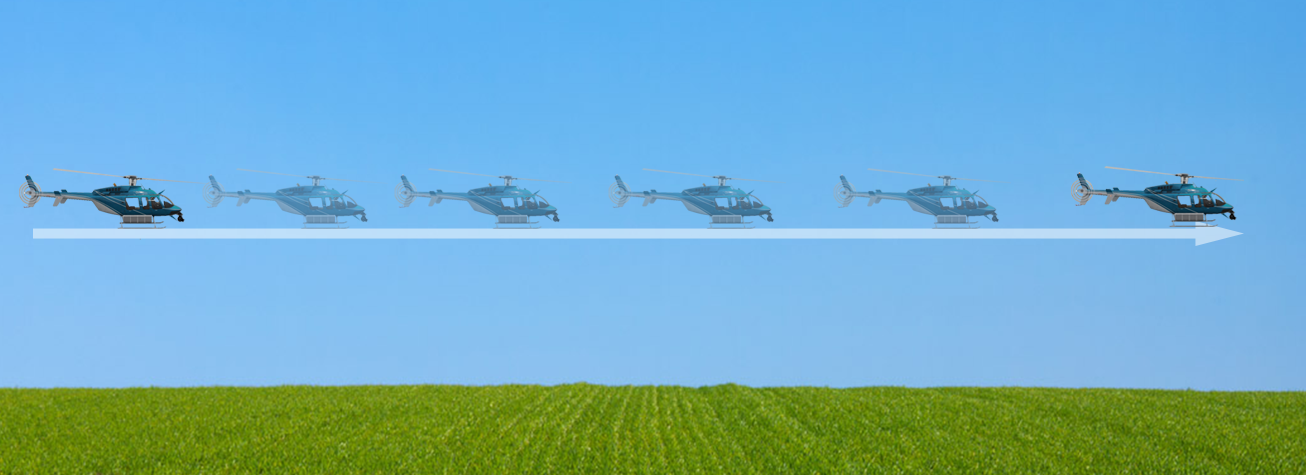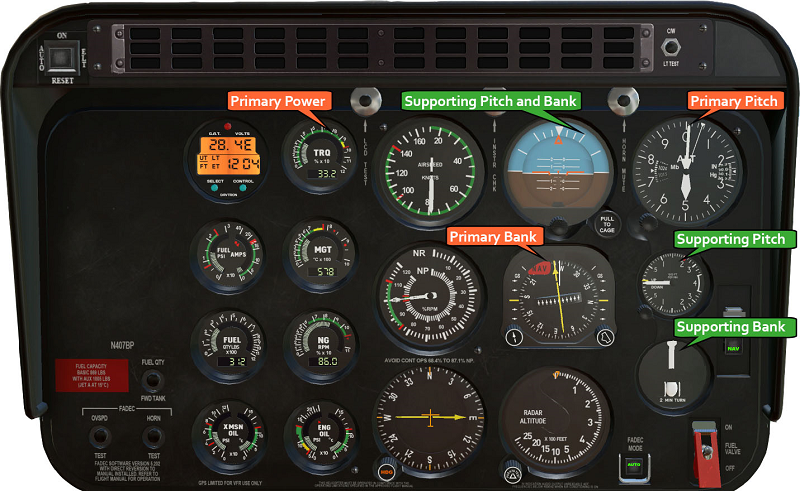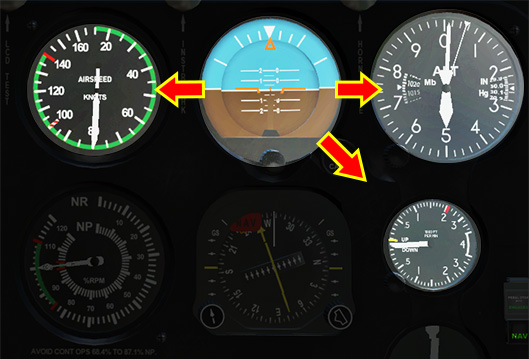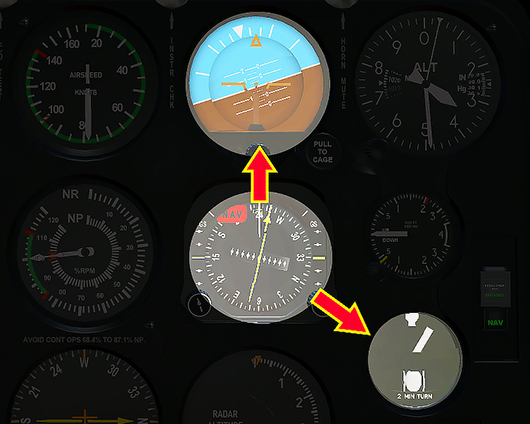¶ Introduction
Straight-and-level unaccelerated flight is controlling pitch, bank and power of the helicopter to maintain a constant altitude, heading, airspeed and pedal trim.

Always bear in mind that straight-and-level flight is the main pillar of the attitude instrument flight and success on every advanced manoeuvre depends on establishing a stable straight-and-level flight before and after the manoeuvre.
¶ Instruments
For straight-and-level flight:
- Altimeter is primary instrument for pitch
- Heading indicator is primary instrument for bank
- Torque/manifold pressure is primary instrument for power
- Attitude indicator is supporting instrument for pitch and bank
- Variometer is supporting instrument for pitch
- Turn-and-slip indicator is supporting instrument for bank control

¶ Procedure
Straight means constant heading, level means constant altitude and unaccelerated means constant airspeed. Straight-and-level unaccelerated flight in IFR is accomplished by keeping the desired heading, altitude and airspeed by reference to the instruments.
¶ Pitch control
Pitch attitude of a helicopter should be established to maintain the desired altitude and airspeed reference to the pitch instruments.

Use the attitude indicator to establish the required pitch to reach target altitude. When altitude has been established, cross-check other pitch instruments to maintain constant altitude.
In level flight, the pitch attitude varies with the airspeed and center of gravity (CG).
- When losing altitude, raise the pitch attitude and adjust power as necessary. When gaining altitude, lower the pitch attitude and adjust power as necessary.
If altitude and airspeed are more than 100 feet and 10 knots low, respectively, apply power in addition to an increase of pitch attitude. If the altitude and airspeed are high by more than 100 feet and 10 knots, reduce power and lower the pitch attitude.
- If the airspeed increases, the nose is too low and should be raised. If the airspeed decreases, the nose is too high and should be lowered.
The VSI indicates zero in level flight and when a movement of the VSI is detected, immediate application of corrective measures prevents bigger errors in altitude and airspeed.
- After making a correction, cross-check the other pitch instruments to determine whether the pitch attitude change is sufficient.
When making initial pitch attitude corrections to maintain altitude, the changes of attitude should be small and applied smoothly. The initial movement of the horizon bar should not exceed one bar width high or low. If a further adjustment is required, an additional correction of one-half bar normally corrects any deviation from the desired altitude.
This one-and-one-half bar correction is normally the maximum pitch attitude correction from level flight attitude.
¶ Bank Control
The Bank attitude of a helicopter should be established to maintain the desired heading reference to the bank instruments.

Use the attitude indicator and the turn indicator to establish the required bank to reach target heading. When heading has been established, cross-check the bank instruments to maintain constant heading.
- To maintain a straight course, keep the miniature aircraft and the horizon bar of the attitude indicator in a position which ensures no deviation in the heading indicator.
A small angle of bank is indicated by a slow change of heading; a large angle of bank is indicated by a rapid change of heading.
- If a turn is noticed, apply opposite cyclic until the heading indicator indicates the desired heading, simultaneously ensuring the ball is centered.
When making the correction to the desired heading, do not use a bank angle greater than that required to achieve a standard rate turn. In addition, if the number of degrees of change is small, limit the bank angle to the number of degrees to be turned.
¶ Power Control
To produce straight-and-level flight, the cross-check of the pitch-and-bank instruments should be combined with the power control instruments. With a constant power setting, a normal cross-check should be satisfactory. When changing power, the speed of the cross-check must be increased to cover the pitch and bank instruments adequately. This is necessary to counteract any deviations immediately.
At any given airspeed, a specific power setting determines whether the helicopter is in level flight, in a climb, or in a descent.
- At constant altitude, cruising airspeed maintained with cruising power results in level flight.
- If a pilot increases the power setting and holds the airspeed constant, the helicopter climbs.
- If the pilot decreases power and holds the airspeed constant, the helicopter descends.
- If the altitude is constant and the airspeed is high or low, change the power to obtain the desired airspeed. During the change in power, make an accurate interpretation of the altimeter, then counteract any deviation from the desired altitude by an appropriate change of pitch attitude.
- If the altitude is low and the airspeed is high, or vice versa, a change in pitch attitude alone may return the helicopter to the proper altitude and airspeed.
- If both airspeed and altitude are low, or if both are high, changes in both power and pitch attitude are necessary.
It is very important to note down your specific power setting in straight-and-level flight. This specific power setting depends on airspeed and altitude of the aircraft, which means that more than one specific power setting should be noted during flight. After making altitude and speed corrections, returning back to a predetermined power setting makes the flight much more easier.
- Instrument Flying Handbook (FAA-H-8083-15B)
- VID 522050- Creation
- VID 496402 - Wiki.js integration